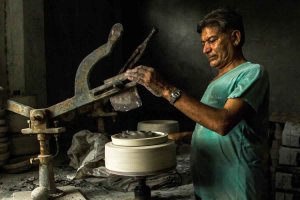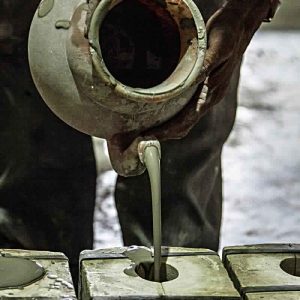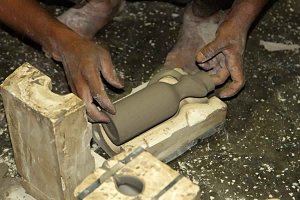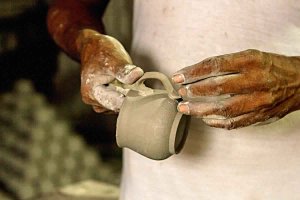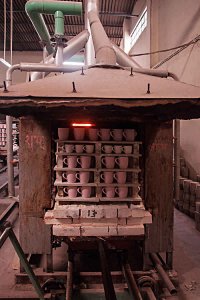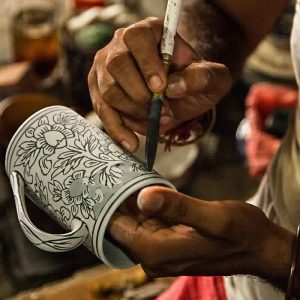Khurja Pottery
Are you looking for Khurja Pottery then check out this post to know more. Khurja pottery is historic Indian pottery work manufactured in Khurja of the Bulandshahr district in Uttar Pradesh state, India. Khurja is a city (and a municipal board) in the Bulandshahr locality in the Indian state of Uttar Pradesh. It is situated around 87 km from Delhi. A huge portion of the ceramics used in the country is supplied by Khurja supplies hence it is sometimes called “The Ceramics City“. The town is also famous for its special sweet and dishes.
History of Khurja Pottery:
Khurja pottery history goes back to around the old century when few wounded soldiers (army men) from Timur’s (Mughal emperor) army decided to remain behind. A number of these soldiers become potters and they brought this technique with them.
During World War, the ban was imposed on various making household utensils and the import of ceramic goods was drastically curtailed. To meet the demand of ceramic wares mainly for war hospitals, the Government of U.P established a ceramic unit. After the war, the factory was closed in 1948 due to lack of demand for its products. The factory was equipped with all material. Instead of closing the factory, the Government of Uttar Pradesh decided to convert it into a Pottery Development Centre.
Making of Khurja pottery
A) Preparing the Clay for Khurja Pottery:
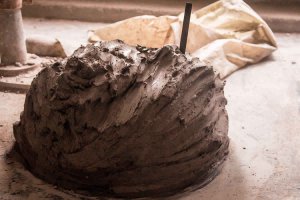
All raw materials (dry clay powder, water, Multani mitti, dry sand) are mixed in a ratio (trade secret) and ground in Ball-mill equipment for around 15 hours to get a homogenous mix of clay dough and further placed between pan filter to remove the excess water content and clay disc of size around 1.5 feet diameter is the output of this process. Clay discs are again passed through Pug-mill equipment for the pugging process is done to get super fine clay dough. Archimedes screw in pug-mill pushes the clay, horizontal and vertical gesture. Two types of clay material are produced, liquid clay and solid clay.
B) Clay Molding Process for Khurja Pottery:
The molding process is generally done for huge products like vases, bowl, and pots. The mold of the required article with the product cavity is arranged using Plaster of Paris (POP). Clay is mixed in a melted solution with no lumps as physical. Clay result is poured into the mold until the clay result fills the cavity in the mold. The mold box is shaken/rotated/tilted gently to avoid air bubbles and excess clay.
C) Smoothening and Painting Process for Khurja Pottery
Dried products are subjected to a semi-finish process to improve the exterior finish by sanding with sandpaper. Painting in ceramic pottery divided into 2 categories, Mughal art (old art) and normal painting with motifs on the outer surface. Mughal art (traditional art ) is painted with cobalt (Cb)-bluish color followed by a colorless lead(Pb) glazing, whereas another category is drawing motifs like floral or geometric patterns on the pottery.
D) Glazing process for Khurja Pottery:
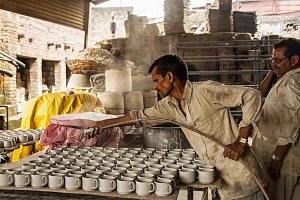
Glazing is a glossy layer fused to ceramic objects which are used to color, decorate, waterproof and to harden the ceramic. Glazes can be a transparent, opaque, translucent, glossy, matte finish, etc. Glazes are manufactured up from three basic elements, glass former, melter and binder.
E) Firing Process for Khurja Pottery:
It’s an action done in a covered kiln. The earlier brick kiln was used but nowadays it is replaced by gas or electric kiln with a temp control technology which is easy for the operator and to avoid the number of damages.
Advantages of Khurja Pottery
- The Health benefits of clay pot cooking come from its ability to disperse steam throughout cooking. This provides huge moisture and helps to cook with less oil and gas.
- Since Clay is alkaline in nature when a meal is cooked it neutralizes the PH balance of the meal which makes food less acidic
- The slow cooking process retains all the nutrients of the food that we cook in these pots
- If you season your pot properly, it will become durable and likely last for a long time. khurja pots can last up to 3-4 years.
Conclusion of Khurja Pottery
Traditional Indian artwork that is very beautiful and unique Khurja can be reached by road or train. A long drive from Delhi on a direct route has huge traffic and takes about 2 to 3 hr. Time can be saved by using a new expressway from Delhi to Noida, then the Dankaur station road to Sikandrabad, which is 40 km from Khurja. Khurja is a very beautiful city it has a mixed crowd of Hindus and Muslims you can see great bonding between both religions.


